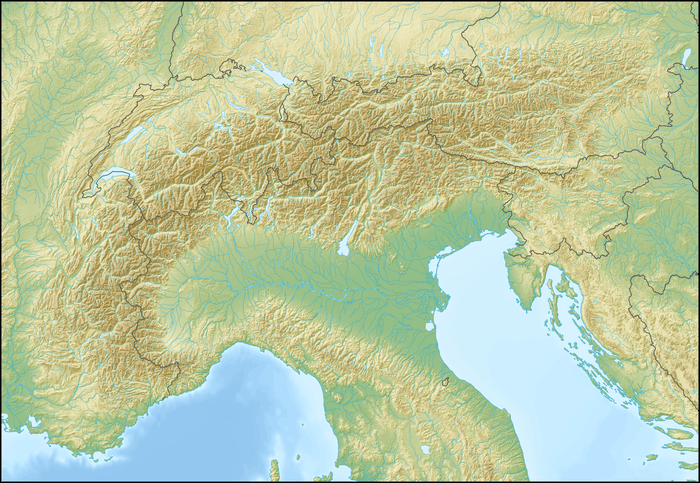Hahnenkamm, Kitzbühel
The Hahnenkamm is a mountain in Europe, directly southwest of Kitzbühel in the Kitzbühel Alps of Austria. The elevation of its summit is 1,712 metres (5,617 ft) above sea level.
| Hahnenkamm | |
|---|---|
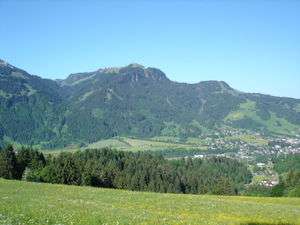 Hahnenkamm above Kitzbühel, May 2005 | |
| Highest point | |
| Elevation | 1,712 m (5,617 ft) [1] |
| Coordinates | 47°25′27″N 12°21′55″E |
| Geography | |
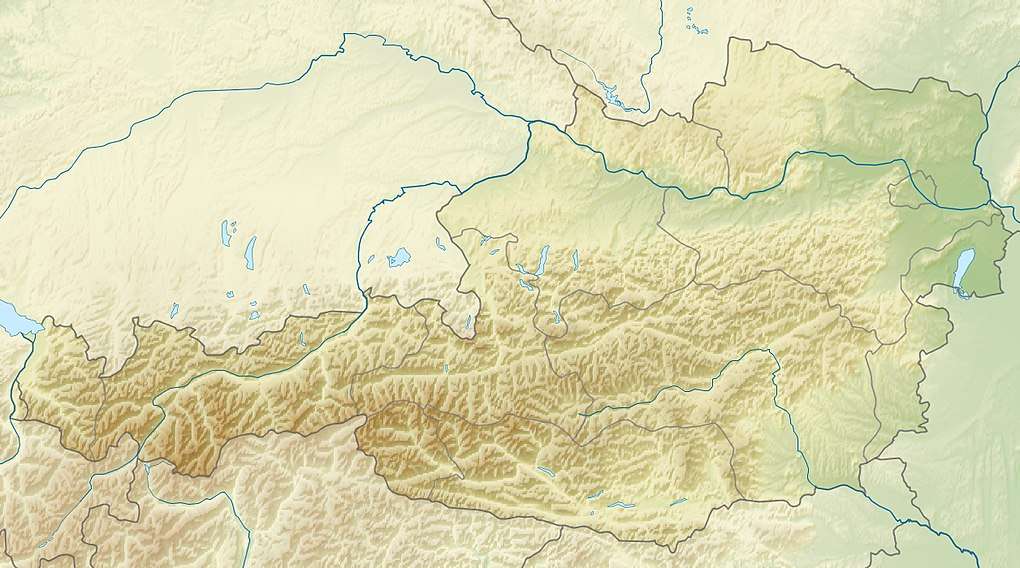 Hahnenkamm Location in Austria | |
| Location | Tyrol, Austria |
| Parent range | Kitzbühel Alps |
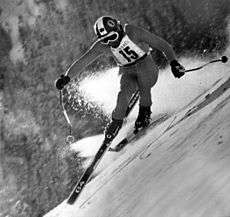
The Hahnenkamm (German: rooster's comb) is part of the ski resort of Kitzbühel, and hosts an annual World Cup alpine ski race, the Hahnenkammrennen. The most famous slope on the Hahnenkamm is the classic downhill course, the Streif (streak, or stripe), which is regarded as the most demanding race course on the World Cup circuit. The course features highly technical, "fall-away" turns (reverse bank), many with limited visibility. It also contains several flat gliding sections, immediately preceded by difficult turns, placing a premium on both technical and gliding skills. A run on the mountain's northeast face, the Streif course, is mostly in the shade in January. It is usually overcast and coupled with fog, the result being "flat" lighting which compounds the course's difficulty.
Hahnenkamm race
The Hahnenkammrennen are the annual races, held since 1931 and a fixture of the men's World Cup since its inception in the 1967 season. The races were originally held in March, and sometimes in early February (1949 & 1951). Beginning in 1953, the races at Kitzbühel have been held in mid to late January, often the week following the Lauberhorn in Wengen, Switzerland, another classic downhill.
Since 1959, the race has been broadcast on Austrian television.[2]
In 2009, as well as in 2008, the total prize money was €550,000.[3]
The Hahnenkamm races are currently held in the following disciplines:[4]
- Super-G on the Streifalm, on Friday
- Downhill on the Streif, on Saturday
- Slalom on the Ganslernhang, on Sunday
Traditionally, the winner of the Hahnenkamm race was determined by the combined results of the downhill and slalom competitions. During the World Cup era, the man most likely to be referred to as Hahnenkammsieger (champion) is the winner of the prestigious downhill race.
The Super-G made its debut at Kitzbühel 25 years ago in 1995, and returned as a regular event in 2000, scheduled the day before the downhill.
Because of challenging weather conditions in January at the top of the mountain, the downhill course is often not run in its entirety. In the decade of 2000–09, the Streif full course was run in only four of the ten years (2001, 2002, 2004, & 2009). Unfortunately, this often eliminates one of the most exciting jumps in ski racing, the Mausefalle (mousetrap), seconds from the top of the course. The competitors reach high speeds quickly out of the starting gate on the Startschuss and fly up to 80 m (260 ft) off the steep jump. Upon landing the racers experience a severe compression immediately followed by a sharp left turn, often negotiated unsuccessfully. Speeds entering the turn are 75–80 mph (120–130 km/h).
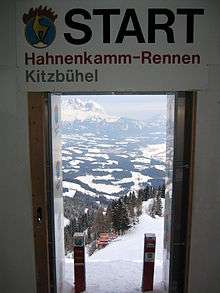
In 2006, morning fog at the top of the course forced race organizers to lower the start 115 m (380 ft) to the middle of the Karusell (carousel), below the Mausefalle. This shortened the length of the course by 347 m (1,140 ft).[5] The downhill race was cancelled in 2005 and 2007.
In 2008, strong upwinds at the Mausefalle caused race officials to lower the start 50 m (160 ft), shortening the course by 100 m (330 ft). This eliminated most of the Startschuss and its instantaneous speed; the Mausefalle was accordingly altered to a speed-inducing pitch, rather than a formidable jump and compression. Though Didier Cuche won the race, the 2008 edition is likely best remembered for the high-speed crash of Scott Macartney on the Zielsprung, seconds before the finish, as well as Bode Miller tying for second with Mario Scheiber after riding the safety fencing in the Steilhang section.
The full course returned in 2009, for the first time in five years, with Didier Défago of Switzerland winning the race. In addition to having the fastest time, he also had the highest speed on the Zielschuss at 88.4 mph (142.3 km/h). It was the second consecutive downhill victory for Défago; he won the Lauberhorn downhill the previous week at Wengen to join a handful of skiers to win both classic races in consecutive weeks.[6] It was last accomplished by Stephan Eberharter of Austria in 2002 and had been 17 years since a Swiss racer won both (1992 - Franz Heinzer). The final training run on Thursday saw the serious crash of Swiss racer Daniel Albrecht, again at the Zielsprung. It resulted in a three-week coma and Albrecht's absence from the World Cup circuit for the remainder of the 2009 season and the entire 2010 season.
The full course was run in 2010 under clear skies and again won by Didier Cuche, who had also won the Super-G the previous day. The only significant crash was by former champion Michael Walchhofer, who twisted into the net fence at the final left turn, less than 20 seconds from the finish; he was quickly back on his feet. Cuche's downhill victory was his third on the Streif, his first was in 1998 on a Friday "extra" race. The Zielsprung was significantly moderated in 2010 due to the serious accidents the previous two years.
In 2011, Didier Cuche won the Hahnenkamm downhill for the fourth time to tie the record with Franz Klammer.[7] A year later, and two days after announcing his retirement at the end of the season, Cuche claimed his third consecutive downhill victory at Kitzbühel and a record fifth total.[8]
Dominik Paris claimed the title in 2013 to become the second winner from Italy and the first in fifteen years.[9][10]
Due to lack of snow in 2014, the lower course was altered. The dramatic Querfahrt sidehill traverse and speed-inducing Zielschuss were bypassed; the racers detoured toward the Ganslern slalom slope, then rejoined the course for the final Rasmusleitn. This extended the overall length by 182 m (199 yd) to 3.494 km (2.171 mi) and reduced the finishing speed. Hannes Reichelt was the first winner from Austria in eight years.
Upper mountain fog in 2015 forced the start to the Seidlalm jump, the lowest in history. Kjetil Jansrud of Norway won in less than a minute on the lower 50% of the course.[11]
High winds in 2016 lowered the start 40 m to the top of Mausefalle. On the full course in 2017, Paris became a two-time winner.
Course sections
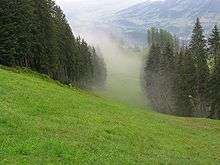
Sections of the Streif downhill course include:[12]
- Startschuss
- Mausefalle (mousetrap) - jump, compression, and left turn
- Karusell (carousel) - S turns
- Steilhang - (steep slope) - extended technical right turn, entrance to the flats
- Brückenschuss & Gschöss - gliding flats
- Alte Schneise (old corridor)
- Seidlalmsprung (jump at Seidlalm) - introduced in 1994
- Lärchenschuss - gliding among larch trees
- Hausberg (local mountain) - jump & sharp left corner
- Querfahrt (traverse) - a rough sidehill of glare ice
- Zielschuss (with compression & jump) - speeds over 140 km/h (87 mph)
- Rasmusleitn to the finish (Ziel).
Facts and figures
| Streif - Downhill | |
|---|---|
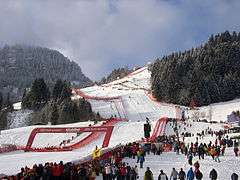 Finish area (Ziel) in 2011 | |
| Vertical | 860 m (2,822 ft) |
| Top elevation | 1,665 m (5,463 ft) |
| Base elevation | 805 m (2,641 ft) |
| Longest run | 3.312 km (2.058 mi) |
- The length of the Streif course is 3.312 km (2.058 mi).[12]
- The starting gate is at an elevation of 1,665 m (5,463 ft) above sea level;
the Streif vertically descends 860 m (2,822 ft) to the finish at 805 m (2,641 ft).[12] - The average grade of the course is 27 percent (15.1 degrees).
- The maximum grade is 85% (40.4°) at the Mausefalle; minimum is 2% (1.1°) [13]
- The record for the full 3.3 km course was set in 1997 by Fritz Strobl of Austria at 1:51.58,[14] an average speed of 106.9 km/h (66.4 mph), and an average vertical descent rate of 7.7 m/s (25.3 ft/sec).
- The first non-European to win a downhill race at Kitzbühel in the World Cup era was Ken Read of Canada in 1980.[15] Previously, the only non-European champion was Buddy Werner of the U.S., who won in 1959 at age 22. Canadians won races four consecutive years from 1980–83; the only non-European winner since is Daron Rahlves of the U.S., who prevailed on an abbreviated course of 2.0 km (1.2 mi) due to fog in 2003.
- Four victories have gone to Scandinavians, all from Norway. Atle Skårdal was the first in 1990 and Lasse Kjus won twice, in 1999 and 2004; both of Kjus' victories were "extra" races, held on Friday and Thursday, respectively. Kjetil Jansrud won on a shortened course in 2015.[11]
- The Streif course was one of several featured in the 1969 movie Downhill Racer, starring Robert Redford and Gene Hackman. It was shown as itself and later as the Olympic course, with race footage from the 1969 race.
- The Streif course was first used in 1937; eight years without Hahnenkamm races followed (1938–45) until the return in 1946.[16]
- Since returning in 1946, the downhill races have been run in all but eight years: 1952, 1964, 1970, 1971, 1988, 1993, 2005, & 2007.
Downhill champions
The following is a list of Hahnenkamm downhill winners, with their winning times:[17]
| Year | Date | Winner | Nat. | Time | Notes |
|---|---|---|---|---|---|
| 2020 | January 25 | Matthias Mayer | 1:55.59 | ||
| 2019 | January 25 | Dominik Paris (3) | 1:56.82 | (Friday) - moved from Saturday due to bad weather forecasts | |
| 2018 | January 20 | Thomas Dressen | 1:56.15 | ||
| 2017 | January 21 | Dominik Paris (2) | 1:55.01 | ||
| 2016 | January 23 | Peter Fill | 1:52.37 | high winds - start lowered 40 m to top of Mausefalle, length reduced 100 m | |
| 2015 | January 24 | Kjetil Jansrud | 0:58.16 | fog - shortened to lower 50% of course - 1.6 km [11][18] | |
| 2014 | January 25 | Hannes Reichelt | 2:03.38 | lack of snow, Querfahrt and Zielschuss bypassed, course length extended | |
| 2013 | January 26 | Dominik Paris (1) | 1:57.56 | [19] | |
| 2012 | January 21 | Didier Cuche (5) | |
1:13.28 | snowing - shortened to lower 60% of course - 2.0 km [20] |
| 2011 | January 22 | Didier Cuche (4) | |
1:57.72 | [21] |
| 2010 | January 23 | Didier Cuche (3) | |
1:53.74 | [22] |
| 2009 | January 24 | Didier Défago | |
1:56.09 | [6][23] |
| 2008 | January 19 | Didier Cuche (2) | |
1:52.75 | start lowered 50 m to top of Mausefalle, due to upwinds [24] |
| 2007 | no downhill or Super G races held - lack of snow, warm temperatures [25] | ||||
| 2006 | January 21 | Michael Walchhofer | 1:46.75 | start moved to the bottom of the Mausefalle due to fog/safety [26] | |
| 2005 | no downhill race held - snow/rain - safety [27] | ||||
| 2004 | January 24 | Stephan Eberharter (2) | 1:55.48 | ||
| 2004 | January 22 | Lasse Kjus (2) | 1:58.78 | (Thursday) | |
| 2003 | January 25 | Daron Rahlves | 1:09.63 | shortened due to fog - lower 60% of course - 2.0 km [28] | |
| 2002 | January 19 | Stephan Eberharter (1) | 1:54.21 | ||
| 2001 | January 20 | Hermann Maier | 1:56.84 | ||
| 2000 | January 22 | Fritz Strobl (2) | 1:46.54 | shortened | |
| 1999 | January 23 | Hans Knauß | 1:54.18 | ||
| 1999 | January 22 | Lasse Kjus (1) | 2:14.13 | (Friday) | |
| 1998 | January 24 | Kristian Ghedina | 2:05.49 | ||
| 1998 | January 23 | Didier Cuche (1) | |
2:31.55 | two shortened runs [29] |
| 1997 | January 25 | Fritz Strobl (1) | 1:51.58 | record time for full course, set 23 years ago [14] | |
| 1997 | January 24 | Luc Alphand (3) | 2:12.55 | (Friday) | |
| 1996 | January 13 | Günther Mader | 1:54.29 | record: held for 1 year | |
| 1995 | January 14 | Luc Alphand (2) | 1:40.97 | shortened | |
| 1995 | January 13 | Luc Alphand (1) | 1:40.33 | (Friday) shortened | |
| 1994 | January 15 | Patrick Ortlieb | 2:00.12 | ||
| 1993 | no races held - lack of snow - snowmaking added that summer | ||||
| 1992 | January 18 | Franz Heinzer (3) | |
1:56.63 | |
| 1992 | January 17 | Franz Heinzer (2) | |
1:56.04 | (Friday) record: held for 4 years |
| 1991 | January 12 | Franz Heinzer (1) | |
1:58.71 | |
| 1990 | January 20 | Atle Skårdal | 2:26.20 | ||
| 1989 | January 13 | Marc Girardelli | 2:01.25 | (Friday) | |
| 1989 | January 14 | Daniel Mahrer | |
1:58.42 | |
| 1988 | no races held | ||||
| 1987 | January 25 | Pirmin Zurbriggen (3) | |
1:58.06 | |
| 1986 | January 18 | Peter Wirnsberger (2) | 2:02.04 | ||
| 1986 | January 17 | Peter Wirnsberger (1) | 2:01.77 | (Friday) | |
| 1985 | January 12 | Pirmin Zurbriggen (2) | |
2:08.65 | |
| 1985 | January 11 | Pirmin Zurbriggen (1) | |
2:06.95 | (Friday) |
| 1984 | January 21 | Franz Klammer (4) | 2:02.82 | ||
| 1983 | January 22 | Todd Brooker | 2:01.96 | ||
| 1983 | January 21 | Bruno Kernen | |
2:06.68 | (Friday) |
| 1982 | January 16 | Steve Podborski (2) | 1:57.24 | ||
| 1982 | January 15 | Harti Weirather | 1:57.20 | (Friday) record: held for 10 years [14] | |
| 1981 | January 17 | Steve Podborski (1) | 2:03.46 | ||
| 1980 | January 12 | Ken Read | 2:04.93 | ||
| 1979 | January 20 | Sepp Ferstl (2) | 2:04.48 | ||
| 1978 | January 21 | Josef Walcher (2) & Sepp Ferstl (1) |
2:07.81 | tie | |
| 1978 | January 20 | Josef Walcher (1) | 2:06.90 | (Friday) | |
| 1977 | January 15 | Franz Klammer (3) | 2:09.71 | ||
| 1976 | January 25 | Franz Klammer (2) | 2:03.79 | ||
| 1975 | January 18 | Franz Klammer (1) | 2:03.22 | record: held for 7 years | |
| 1974 | January 26 | Roland Collombin (2) | |
2:03.29 | record: held for 1 year |
| 1973 | January 27 | Roland Collombin (1) | |
2:13.32 | |
| 1972 | January 15 | Karl Schranz (4) | 2:24.36 | ||
| 1972 | January 14 | Karl Schranz (3) | 2:23.70 | (Friday) | |
| 1971 | no downhill race held | ||||
| 1970 | no downhill race held | ||||
| 1969 | January 18 | Karl Schranz (2) | 2:18.80 | ||
| 1968 | January 20 | Gerhard Nenning | 2:14.49 | ||
| 1967 | January 21 | Jean-Claude Killy | 2:11.82 | record: held for 7 years [14] | |
| 1966* | Karl Schranz (1) | 2:16.6 | record: held for 1 year | ||
| 1965 | Ludwig Leitner | 2:30.8 | |||
| 1964 | no races - lack of snow | ||||
| 1963 | Egon Zimmermann | 2:20.7 | record: held for 3 years | ||
| 1962 | Willi Forrer | |
2:37.6 | ||
| 1961 | Guy Périllat | 2:29.2 | |||
| 1960 | Adrien Duvillard | 2:26.1 | record: held for 3 years[14] | ||
| 1959 | Buddy Werner | 2:33.4 | record: held for 1 year | ||
| 1958 | Anderl Molterer (2) | 2:40.7 | record: held for 1 year | ||
| 1957 | Toni Sailer (2) | 2:47.1 | |||
| 1956 | Toni Sailer (1) | 2:57.8 | |||
| 1955 | Anderl Molterer (1) | 2:46.2 | record: held for 3 years | ||
| 1954 | Christian Pravda (2) | 2:47.9 | record: held for 1 year | ||
| 1953 | January 17 | Bernhard Perren | |
2:54.5 | record: held for 1 year |
| 1952 | no races | ||||
| 1951 | February 7 | Christian Pravda (1) | 2:57.1 | ||
| 1950 | March 11 | Fritz Huber | 3:04.3 | ||
| 1949 | February 5 | Egon Schöpf | 3:03.0 | ||
| 1948 | March 13 | Helmut Lantschner | 3:16.3 | ||
| 1947 | March 7 | Karl Feix | 3:36.0 | ||
| 1946 | March 2 | Thaddäus Schwabl (2) | 3:04.3 | ||
| 1945 | no races | ||||
| 1944 | no races | ||||
| 1943 | no races | ||||
| 1942 | no races | ||||
| 1941 | no races | ||||
| 1940 | no races | ||||
| 1939 | no races | ||||
| 1938 | no races | ||||
| 1937 | March 19 | Thaddäus Schwabl (1) | 3:53.1 | first on Streif course | |
| 1936 | March 7 | Freidl Pfeifer | 5:03.2 | ||
| 1935 | March 23 | Siegfried Engl | 4:38.8 | ||
| 1934 | no races | ||||
| 1933 | no races | ||||
| 1932 | March 19 | Walter Prager | |
7:56.4 | |
| 1931 | March 28 | Ferdl Friedensbacher | 4:34.2 |
* pre-World Cup era
Each downhill champion's name is affixed to a gondola car on the Hahnenkammbahn lift,
which extends from the Kitzbühel base to the top of the Hahnenkamm mountain.
Vertical Up
In the open Streif VerticalUp event, first held in 2011, participants race the Streif upwards to the start booth of the ski race,[30] with free choice of equipment (cross-country skis, shoes with spikes, etc).
Notes and references
- Hahnenkamm, Kitzbühel in Austria-Forum (in German) (at AEIOU)
- "Heuer zum 50. Mal: Kitzbühel total im ORF" (in German). ORF. Archived from the original on 2011-07-06. Retrieved 2009-01-24.
- "550.000 Euro Preisgeld für Kitz-Sieger" (in German). Tiroler Tageszeitung. 2009-01-21. Retrieved 2009-01-24.
- "Hahnenkamm racing courses". Kitzbüheler Ski Club. Archived from the original on November 21, 2008. Retrieved 2008-12-01.
- "Results Kitzbühel Downhill 2006" (PDF). International Ski Federation. Archived from the original (PDF) on 2011-05-26. Retrieved 2009-01-27.
- "Defago wins World Cup downhill on Streif". USA Today. Associated Press. 2009-01-24. Retrieved 2009-01-31.
- "Cuche wins Hahenkamm DH, pushes Bode Miller to second". Ski Racing.com. January 22, 2011.
- "Cuche wins Hahnenkamm DH for record fifth time". Ski Racing.com. January 21, 2012.
- "Dom Paris wins Hahnenkamm DH for Italy". Ski Racing.com. January 26, 2013.
- Jelusic, Ana (January 26, 2013). "Dominik Paris tames the Streif". FIS Alpine.com.
- Mintz, Geoff (January 24, 2015). "Jansrud wins shortest-ever Hahnenkamm downhill". Ski Racing.
- "Racing courses overview diagram". Kitzbüheler Ski Club. Retrieved 2013-01-26.
- "Downhill "Streif"". Kitzbüheler Ski Club. Archived from the original on 2013-04-20. Retrieved 2013-01-26.
- "Distance Records "Streif" Course record". Kitzbüheler Ski Club. Archived from the original on 2013-01-06. Retrieved 2013-01-26.
- "Results for Ken Read". FIS-ski.com. Archived from the original on 2012-08-05. Retrieved 2014-02-15.
- "Results - Former HKR" (in German). Kitzbüheler Ski Club. Archived from the original on 2013-01-29. Retrieved 2013-01-26.
- "Honor Roll - the champions, men, downhill". Kitzbüheler Ski Club. Archived from the original on 2012-01-23. Retrieved 2013-01-26.
- "Results Kitzbühel Downhill 2015". International Ski Federation. Retrieved 2015-01-25.
- "Results Kitzbühel Downhill 2013". International Ski Federation. Archived from the original on 2013-01-29. Retrieved 2013-01-26.
- "Results Kitzbühel Downhill 2011". International Ski Federation. Archived from the original on 2012-01-23. Retrieved 2012-01-21.
- "Results Kitzbühel Downhill 2011". International Ski Federation. Archived from the original on 2011-01-24. Retrieved 2011-01-22.
- "Results Kitzbühel Downhill 2010". International Ski Federation. Archived from the original on 2010-01-26. Retrieved 2010-01-25.
- "Results Kitzbühel Downhill 2009". International Ski Federation. Archived from the original on 2009-04-21. Retrieved 2010-01-25.
- "Results Kitzbühel Downhill 2008". International Ski Federation. Archived from the original on 2011-05-26. Retrieved 2008-12-01.
- "Like it or not, men prep for Kitz slalom-fest". skiracing.com. 2007-01-26. Retrieved 2009-01-20.
- "Kitzbuehel: Walchhofer wins downhill; Rahlves, Miller check in at 3-4". skiracing.com. 2006-01-21. Retrieved 2009-01-27.
- "KITZBUEHEL 2005: Hahnenkamm downhill cancelled for safety reasons". skiracing.com. 2005-01-22. Retrieved 2009-01-20.
- "Results Kitzbühel Downhill 2003" (PDF). International Ski Federation. Archived from the original (PDF) on 2011-05-26. Retrieved 2009-01-27.
- "Results Kitzbühel Extra Downhill 1998". International Ski Federation. Archived from the original on 2011-06-04. Retrieved 2010-01-25.
- "Streif Vertical Up - Kitzbuehel - Tyrol/Austria". Streif Vertical Up Kitzbühel. Retrieved 2019-08-10.
External links
![]()
- Hahnenkamm race (in English)
- KitzSki (in English)
- FIS-ski.com - 2017 Hahnenkamm downhill results
- Skimap.org - Kitzbühel area ski maps
Videos
- YouTube video - 1981 race live - 18-Jan-1981
- YouTube video - 1981 race - crashes only
- YouTube video - Franz Klammer, age 30, wins his 4th Hahnenkamm on full course - 21-Jan-1984
- YouTube video - career-ending crash of Todd Brooker, 1983 winner, at top of Zielschuss, Friday training run - 24-Jan-1987
- YouTube video - Kristian Ghedina on full course - spread eagles at Zielsprung - 6th place - 24-Jan-2004
- YouTube video - Hermann Maier on full course - 9th place - 24-Jan-2004[1]
- YouTube video - 2004 race coverage from ORF (Austrian Broadcasting) - 24-Jan-2004
- YouTube video - Bode Miller skis onto fence exiting Steilhang, takes 2nd - 19-Jan-2008
- YouTube video - crash of Scott Macartney at Zielsprung, takes 33rd - 19-Jan-2008
- YouTube video - crash of Daniel Albrecht at Zielsprung - Thursday training run - 22-Jan-2009
- YouTube video - Didier Défago wins 2009 Hahnenkamm on full course - 24-Jan-2009
- YouTube video - crash of Hans Grugger at Mausefalle - Thursday training run - 20-Jan-2011
- FIS-ski.com Archived 2011-05-26 at the Wayback Machine - results of 2004 race
